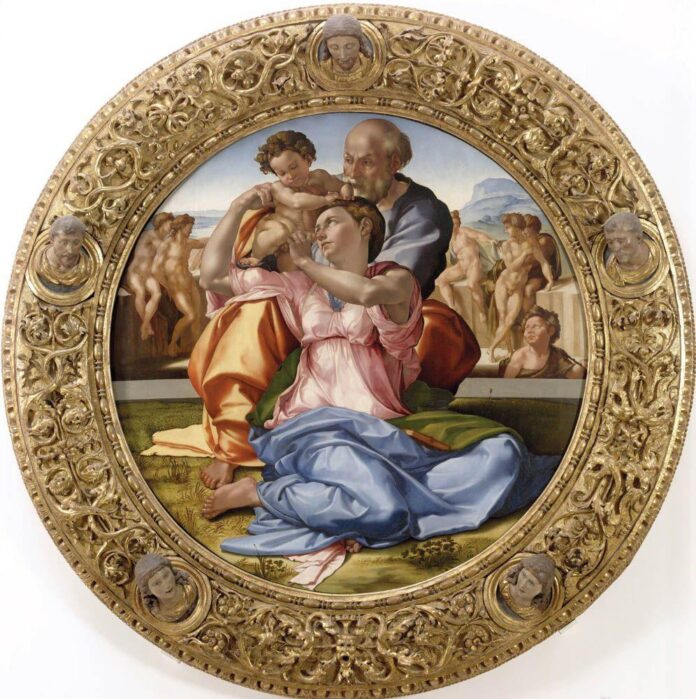The Italian government plans to halt the sale of digital copies of masterpieces by artists such as Leonardo da Vinci and Michelangelo drawn from Italy’s most celebrated museums. The move comes after the sale of a digital facsimile based on Michelangelo’s Doni Tondo (1505-06) made €240,000 last year netting the Galleria degli Uffizi in Florence €70,000, the museum recently revealed.
The work was minted by a Milan-based company called Cinello as part of a five-year agreement. But the terms of the contract raised concerns, especially the fact that €100,000 was spent on “production costs”. The contract with Cinello states that “income due to the reproduction of the image is split in half between the company and the museum; the Cinello copy made about €140,000 [on the €240,000 sale], so the Uffizi received €70,000”, says an Uffizi spokesperson.

Michelangelo’s Doni Tondo Galleria degli Uffizi
The saga has sparked concerns about whether major works are up “for sale”. An article in the Italian newspaper La Repubblica in May asked: “Who owns Michelangelo’s Doni Tondo? Who has the legal rights linked to the work? If the buyer ever decides to exhibit it, can he do it without the permission of the Uffizi? Basically, do we not risk losing control of our heritage in a time when we are increasingly moving towards the metaverse?”
A spokesman for Massimo Osanna, the director general of museums in Italy, tells The Art Newspaper: “Given that the matter is complex and unregulated, the ministry has temporarily asked its institutions [museums and archaeolgical sites] to refrain from signing contracts relating to NFTs. The basic intention is to avoid unfair contracts.” He adds that directives for institutions in this field will shortly be issued.
A Cinello spokesperson says that the agreement signed with the Uffizi is based on splitting net revenues in half. “From the sale price is deducted: the VAT, the selling commission, the cost of the production of the frame and 20% of operating costs for Cinello. The partner museum is informed of all costs,” he says. The spokesperson stresses that Cinello makes digitally-encrypted works (DAWs) rather than NFTs (non-fungible tokens), though for some works, an NFT token is created on the blockchain.
He points out that the company does not hold exclusive rights with public museums. “All rights to the work remain with the museum that owns the original image. We create a new [image] linked to our patent, which is the DAW. The collector who buys the DAW cannot exhibit it in public exhibitions according to the contract; the work is only for private use. DAWs are created precisely to maintain control—which remains in the hands of Cinello and the partner museums—and not to disperse [Italian] heritage in the digital world.” Buyers can resell works on the Cinello platform; the museums involved would subsequently receive royalties on any additional sales.
“The Ministry [of Culture] has not blocked our existing contracts; it has blocked the possibility for museums to make new deals on digital images. We are very pleased that the ministry has issued guidelines for digital works. We hope that the legislation can also be quickly enacted to regulate this market,” says the spokesperson. Cinello is working with ten other Italian state museums such as Museo di Palazzo Pretorio and Pinacoteca di Brera di Milano on digital reproductions.
Meanwhile, Gian Luca Comandini, a blockchain expert, believes that the Uffizi did not “work in the right way” when commissioning the works from Cinello. “I hope that the Italian Ministry of Culture will soon be able to establish a working committee and introduce common regulations covering NFTs, the metaverse and web3 protocols [led by blockchain],” he says.
The Uffizi spokesperson says: “The museum didn’t sell anything but granted the use of the image—the sale of the digital artwork is all down to Cinello. It is false to say that the museum sold the Tondo copy.” The museum’s partnership with Cinello lasted five years and expired in December 2021, adds the spokesperson. Under the contract, 40 digital works were due to be produced. “During this time Cinello had the right to make NFTs of the works that were part of the agreement; only the Tondo, however, was sold,” says the spokesperson.
An Uffizi statement adds that “since the 1990s, the permits service of the Uffizi Galleries has authorised the use of dozens and dozens of images of works requested according to the legislation in force and always in a non-exclusive way; for many years [the museum has issued] digital images which are subject to the same [conditions] as those on paper or in other media”.

























